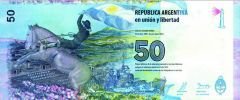Argentina’s 50 Peso Banknote: Another Myth Exposed
Argentina’s new 50 peso note, which goes into circulation in March 2015, is a crude propaganda initiative. On one side, it carries a map of the Falklands; on the other, it has an image of the gaucho, Antonio Rivero, in a heroic horseback pose, against a background of the Argentine cemetery in Darwin, on the Falkland Islands, and the ill-fated Argentine cruiser ‘ARA General Belgrano’.
Whilst it is being rightly mocked for its poor design and obvious propagandist intent, the note perpetuates the myth that Antonio Rivero was an Argentine national hero fighting against the British. Nothing is further from the truth.
The myth suggests that Rivero led an uprising against British rule in the Falklands in 1833. In fact, it was a bloody attack on representatives of Luis Vernet, a merchant from Buenos Aires, who had established a small settlement in Port Louis. The attack, which led to the murder of Vernet’s five top employees, was caused by a dispute over pay for the construction of a corral, resentment over the gauchos’ poor working conditions and payment in Vernet’s worthless promissory notes. There was no high-minded or patriotic intent involved – and this was confirmed by a report issued by Argentina’s own History Academy in 1966.
At the time of the attack, there was no official British presence in the Falklands – so it can hardly be presented as a protest against British rule. And when HMS Challenger arrived in January 1834 to restore order, it was Rivero who betrayed his companions to the British in the hope of immunity – hardly the stuff of a hero. A Buenos Aires newspaper of the time reported the murders as ‘appalling crimes’ without any suggestion of political motivation.
The myth of Rivero as a nationalist, anti-British hero only really began in 1956 in a polemic authored by an Argentine historian who, a decade later, developed a further flight of fancy, to the effect that Rivero had died fighting in the battle in 1845 against an Anglo-French fleet at the Vuelta de Obligado in the River Plate. But whilst there may have been someone of that name who died in that engagement, it was a common name and there is nothing more definite to prove that it was the same man. The true circumstances of Rivero’s death are, in fact unknown.
The same historian also claimed in 1966 that Rivero had earlier been a Captain in the Argentine Army forced to flee to the Falklands in 1829 to escape persecution by the so-called ‘Decembristas’ following the deposition and execution of Buenos Aires Governor, Manuel Dorrego, in December 1828. Rivero, an illiterate, is hardly likely to have been an army officer and is in any case recorded as working as a gaucho in the Falklands before these events.
Serious Argentine historians have long been uncomfortable about mythologizing Rivero. At the time of the Argentine invasion in 1982, Stanley was initially named ‘Puerto Rivero’ by the occupying forces but, on historical advice, this was swiftly changed, first to ‘Puerto de las Islas Malvinas’ and then from 21 April 1982 to ‘Puerto Argentino’. Despite an undertaking by an earlier Argentine administration in 1999 to review the Spanish place-names that it had given to various locations in the Falklands, Argentina under the Kirchners has never honoured its commitment.
For their own political purposes, the Kirchners have done as much as possible to perpetuate the myth of Rivero as an Argentine patriot, despite convincing evidence to the contrary. This new 50 Peso note is just another, rather poor, example of this.




